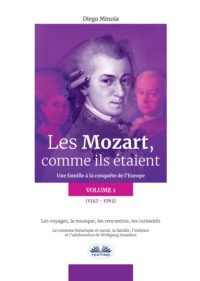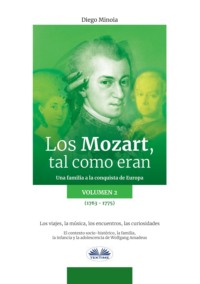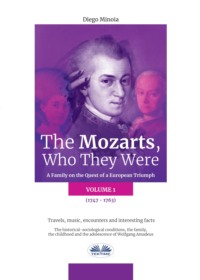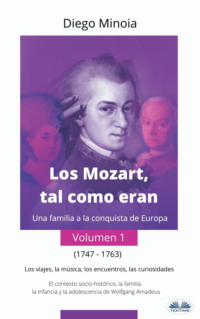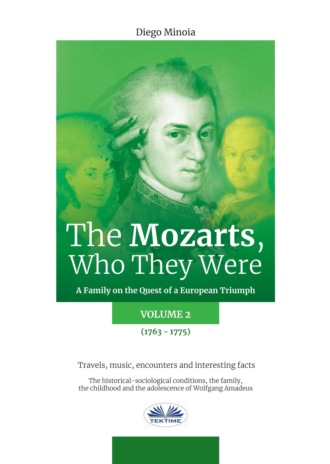
Полная версия
The Mozarts, Who They Were Volume 2

The Mozarts, Who They Were
TRANSLATED BY DENA MARZULLO
Diego Minoia
The Mozarts, Who They Were
A Family on the Quest of a European Triumph
Travels, music, encounters and interesting facts
The historical-sociological conditions, the family,
the childhood and the adolescence of Wolfgang Amadeus
Volume 2
(1763 - 1775)
www.diegominoia.it
All rights reserved
No part of this book may be reproduced without the written consent of the author
Copyright © Diego Minoia 2020
www.diegominoia.it
info@diegominoia.it
ISBN 979-12-200-6604-4
Cover design: Marta Colosio
Diego Minoia
The Mozarts, Who They Were
A Family on the Quest of a European Triumph
Travels, music, encounters and interesting facts
Table of Contents
Volume I
Part 1: Salzburg and the Mozart family
Salzburg - The Prince-Bishops – Interesting facts on Salzburg – Music at the Court of the Prince-Bishopric – The musicians of the Salzburg Court – The Mozart family (mother, sister, father, Wolfgang) – Wolfgang's station in the history of music – The life of the Mozart family in Salzburg – Mozart's earnings – The catalogue of the Mozartian compositions
Part 2: School of thought, culture and society in the 1700s
The geopolitical situation during the 18th century – The Age of Enlightenment – Society during the Mozart epoch – Theater, influence and society – Theater and the impresario – The dedications and the earnings of composers and librettists – The castrated – Protected, borrowed and stolen musicians – Music of the 1700s – The role of the musician during the second half of the 1700s – The Melodramma – Music and the church – The principle forms of church music - The evolution and perfection of musical instruments during the 1700s – Pre-Romantic Mozart?
Part 3: Daily life during Mozart's time
The household in Europe in the 1700s – Pannier or farthingale – Laundry – Ice – Food and the evolution of taste – Artists and their role in society - Various habits and interesting facts: household pets, high fashion à la Française – Paris, the guiding light of fashion – Gossip and aristocratic parlors – The “dark gloom” - Parisian parlors and sex - Conservatories and hospitals for the poor
Part 4: The Mozarts family before the European travels
From 1775 to 1762: Leopold Mozart and the education of prodigious children – The Mozartian epistolary – The letters dating 1755/1756 – Leopold Mozart: part author, part businessman – Augsburg letters to the publisher Lotter – The production of paper until the 1700s – Leopold's astuteness – The Fair – Publishing in the 1700s and the author's rights – Leopold's “ploy” - Taxes in the 18th century – Nannerl and Wolfgang's musical education in Salzburg – Wolfgang's first compositions
Part 5: The first journeys of the Mozart family
Traveling in the 18th century: roads, guides, lodging, dangers – Some history on the postal service until Mozart's epoch – The first journeys: Munich and Vienna – The first journey to Vienna - Vienna, the capital of the Empire – Interesting facts – Epistolary from Vienna – Dress during the 18th century – The Academies – Music at the Court of Vienna – Business and the diversification of consumerism – Interior décor – What did Wolfgang and Nannerl do during their exhibitions? – The phenomenon of the 18th century's child prodigies
Part 6: The Mozarts and the Grand European Tour/1– Germany and the Netherlands
What was the Grand Tour of the 18th century? - The Mozart's Grand Tour “in reverse” - Appointments in every city - Sojourns along the journey: Salzburg, Munich, Augsburg, Ulm, Ludwigsburg, Bruchsal, Schwetzingen, Heidelberg, Mannheim, Worms, Mainz, Frankfurt, Mainz, Koblenz, Bonn, Cologne, Aachen, Liège, Tienen, Leuven, Brussels, Mons, Bonavis, Gourney, Paris
Volume 2
Part 7: The Mozart family and the Grand European Tour/2
Paris: encounters, hopes, gifts, success, interesting facts. Wolfgang's Parisian compositions
Part 8: The Mozart family and the Grand European Tour/3 – London
London: a “new” world, formative musical encounters, marketing strategies and government crisis. Wolfgang's “Londonese” compositions
Part 9: The Mozart family and the Grand European Tour/4 – The long return trip
Calais, Dunkirk, Lille, Ghent, Antwerp, Rotterdam, The Hague, Amsterdam, The Hague, Haarlem, Amsterdam, Utrecht, Antwerp, Brussels, Valenciennes, Cambrai, Paris, Dijon, Lyon, Geneva, Lausanne, Bern, Zürich, Winterthur, Schaffhausen, Donaueschingen, Dillingen, Augsburg, Munich, Salzburg
Part 10: Salzburg / Vienna / Salzburg
The return to daily life in Salzburg – A period of settling in and growth for Wolfgang in acquiring further musical knowledge – A second journey to Vienna – A period of additional Salzburg study in preparation for the upcoming journey to Italy
Intermezzo
The Grand Tour in Italy in the 18th century, the opinions and diaries of other travelers on the Grand Tour, Europe and Italy during the second half of the 18th century
Part 11: The first journey to Italy
Salzburg, Innsbruck, Bolzano, Rovereto, Verona, Mantua, Milan, Lodi, Parma, Bologna, Florence, Rome, Sessa Aurunca, Capua, Naples, Rome, Civita Castellana, Terni, Spoleto, Foligno, Loreto, Senigallia, Pesaro, Rimini, Imola, Bologna, Parma, Piacenza, Milan, Turin, Milan, Brescia, Verona, Vicenza, Padua, Venice, Padua, Vicenza, Verona, Rovereto, Brixen, Innsbruck, Salzburg
Part 12: The second journey to Italy
In Milan for the composition of the theatrical serenade Ascanio in Alba – Back to Salzburg
Part 13: The third journey to Italy
In Milan for the composition of the opera Lucio Silla – Wolfgang returns to Salzburg to serve the Court
Part 14: Vienna and Munich
Unsuccessful attempts in Vienna – La finta giardiniera “The Disguised Gardener” in Munich – Wolfgang's melancholic return to Salzburg – Mozart is dismissed – Leopold and Wolfgang's separation – Wolfgang's departure with his mother in search of fortune elsewhere
A note to the reader: throughout the book, some parts of the text have been highlighted in gray. These have been included to give further information and in-depth explanation to broaden the understanding of the topic being discussed. There is no harm in passing over these segments to avoid interrupting the narrative related to the Mozart family; you may wish to re-read them later at your leisure. I hope you enjoy these brief “parenthesis” as a contribution to each situation that has been described in its historical and social context.
Introduction
Why this book? Because it has never been written! For years, I had been looking for a book about the Mozart family with these characteristics. Having never found one, as an author of several books, I decided to write it. There are dozens of books published on Mozart; some are biographies of Amadeus, others are detailed and technical musical analysis' of his compositions, and a few are a blend of biographical and musical analysis.
This book is different from all the others, as the reader will realize from the first pages. To begin with, we will be talking about the entire Mozart family, not just Wolfgang. There is no musical analysis of the compositions and the biography was written principally from information drawn from the most direct and reliable source: the Mozartian epistolary. It is rich in subject matter that is not present in other publications on the Mozarts: information about the epoch in which they lived, their way of thinking and living, interesting facts about events and situations of which they were the protagonists, et cetera.
The objective of this labor of love is to offer a new instrument, less specialistic and certainly not musicological, but with a wealth of information, extracting acquired facts that will allow us to completely lose ourselves in the way of life of the mid to late 1700s.
I hope that I have been successful in personifying the Mozarts without downplaying the individual. My aim is to display the evidence with the simplicity and clarity of my decades of interest in Amadeus, Leopold, Nannerl and the thousands of characters in which they came into contact.
Right from the beginning, my intention was to write a book that would be interesting and pleasurable to read with ease and entertainment for musicians - who don't always find informative and specialized publications of detailed study which offers a better understanding of the context in which Mozart lived - as well as for music lovers, who will become acquainted with Mozart as a human, rather than the Salzburg “genius” high on his pedestal, as is often the case.
All will be discussed without the long digressions of a “critique”, but rather with the affinity and affection of which the Mozarts are deserving. What they contributed to mankind far outweighs what they received in return.
I will tell you what the Mozarts were truly like, how they lived and how they thought during the 18th century, with the addition of interesting facts relative to situations or matters where they are pertinent to the reader related to the Mozarts in Salzburg, while they were on their “European Tour” and during the three times they traveled to their beloved Italy.
In Volume 2, we will be looking at the period dating from 1747 – 1775. Nearly thirty years that consisted of the formation of the Mozart family; the birth of their children, the early sojourns from Salzburg that served to introduce the child prodigies to society, the Grand European Tour, the three journeys to Italy and the final attempts in Vienna and Munich by Wolfgang, accompanied by his father.
After this period, Amadeus traveled alone, with the exception of a brief initial journey with his mother between Munich and Paris, where she died. He then relocated definitively to Vienna, where he married, concluding his artistic and human parabola in 1791. The period following 1777, Amadeus returned to a new phase of his life that went beyond his range.
The reader who is interested in this book can choose, based on his or her preference, between the e-book version or the printed hardcopy, both available in two separate volumes.
Part 7
The Mozarts and the Grand European Tour / 2
22nd stop: Paris
Paris (from Friday 18 November 1763 to Tuesday 10 April 1764)
Some information about Paris...
Origins: already a Celtic settlement for centuries, when the Romans arrived in 53 B.C., it was a village occupied by the Parisi. Besieged and conquered, it was renamed Lutetia parisiorum (Lutetia of the Parisii). It then became a Roman city with thermal baths and an amphitheater, and in the 4th century it appeared for the first time with the name of Parisius (the city of Paris) in a text of the historian, Ammiano Marcellino.
During the Mozart's time: after relocating to the French Court of Versailles by will of Louis XIV in 1682, Paris held its place as the capital of France and the cultural and primary economic center. The presence of the residences of all of the principle aristocratic families of the kingdom and of a financial and entrepreneurial class on the rise made it a city rich in theaters and the fashion center that would disseminate throughout the rest of Europe.
Having reached Paris, the Mozarts then stayed at the Hôtel Beauvais, the residence of the Count Eyck, Ambassador of Bavaria. Describing his arrival at the French capital, Leopold Mozart writes that the outskirts of the city looked like a village, but as they travelled toward the center, the landscape changed with well-built and comfortable buildings where, he mentions the palace that hosted them, the planning was so functional, that “even the smallest corners were useful for something”. Obviously, his first complaint was the high cost of everything: nothing is at a good price except the wine. The list of expenses including the board (ten days, excluding bread and wine, cost 2 louis d'or, which corresponded to 22 Salzburg florins) of which there was the daily added cost of two bottles of wine (20 soldis) and bread (4 soldis) to a grand total in 48 Salzburg kreuzers for lunch and 48 soldis for dinner, evidently more frugal.
A complete list of the common coins in use in France and their value of conversion with the Salzburg coin (that Leopold, as tourist still do today, tried to simplify by rounding up the amounts) allowed Haganauer to better understand the extent of the expenses that the Mozart family had to sustain.
This objective of this information, as we have already said, served to deny the fact that the people in Salzburg should not believe that the Mozart family was becoming too wealthy, which would have created envy in the small Princely Court which, from faraway, would not have been possible to defuse.
A lot of the news he reserved to be communicated in person after his return, but some he thought important to write in his letters, for example, the water of Paris: “The worst thing here is the drinking water that is brought from the Seine River, which is revolting”. Actually, the Mozarts were in an enviable situation seeing as they lived in a noble palace and enjoyed the privileges that the rich procured by the master of the house, such as having water in the household while it was a daily and tiring undertaking for the commoners.
Leopold talks about the water-carriers of Paris, having received the “privilege” of the King, were made to pay a State tax to carry out their work which consisted of gathering the water from the river or the fountains and while carrying it in buckets, had to yell “water!” while walking the streets, selling it to who was in need and could pay. In any case, even while fortunate, the Mozarts, like the the aristocrats, had to undergo the daily routine to treat the water, which had to first be boiled and left to sit so the residuals settled to the bottom of the pail.
If this procedure was not scrupulously followed, the consequences were unpleasant; the best case scenario, diarrhea, if not worse. Leopold said that almost all of the tourists who stayed in Paris in the beginning, suffered from this ailment, and that the entire family had to endure it, even if in a more tolerable form.
Water in the 18th century in Europe
To better understand how things have changed in terms of use and abuse over the centuries, the example of water is a perfect representation. In our modern cities today, we take for granted this precious resource. All we have to do is turn a handle and it appears, hot or cold as needed.
It has been calculated that the consumption of water per capita (for domestic, industrial, public and agricultural use) has increased from 200 liters a day during the mid 1900s to 2,000 liters a day in modern times (and beyond that in the more wasteful areas). To have an immediate perception of the difference, just imagine that in the 1700s the average Parisian had 5 liters of water a day available, and 10 liters available at the turn of the century.
It is obvious, with the quantity of water available, that personal hygiene was not among the first and foremost of priorities. Baths were taken in the river in the summer (even though there was a preconceived notion that this practice was harmful to the male gender's body, fearing a loss of physical strength) and in the few public baths.
Approximately 300 bathtubs were available in Paris in 1789 in the public baths and about an additional thousand private bathtubs in the homes of the nobility (but only a tenth of the aristocratic palaces in 1750 had an actual bathroom, although in Versailles, Louis XVI installed six).
So during Mozart's epoch in the European cities, water was not a resource conveniently available to all as it is today.
The scarcity of water was remedied by the amount of underclothes one possessed, moving toward the importance of “good manners”. An unclean body was “covered” by clean clothing (and that is how white clothing became associated with personal virtue).
It was believed that fresh underclothing absorbed the uncleanliness and sweat from the body, leaving it clean. It was, therefore, considered appropriate, as was also ordered by the doctor, to change one's shirt every 2/3 days, more often in the summer or if one was wealthy.
Only the more visible parts of the body were given more attention and care and washed with water: face, hands, neck.
Only a fortunate few (nobility, high-level functionaries, religious institutions and hospitals) received particular “privileges” that allowed them direct access to the public aqueducts, which in any case, were needed by only some neighborhoods.
For the rest, they obtained their provision of water from the common well, at the neighborhood fountain or from traveling salesmen who supplied vessels of water from rivers or canals and went from house to house selling water by the bucket.
However, water from rivers and canals, especially those within the cities, were becoming ever more polluted due to the continual outpouring of waste directly into the watercourses: tanneries, butchers, laundrywomen, etc.
We know that from the 17th century, the main European rivers like the Thames and the Seine, were defined as latrines (the writer Beaumarchais “sarcastically” said that “in the evening the Parisians drink what they had dumped into the river that morning”), but this is still where the Londoners and Parisians obtained the essential quantity of water to quench the thirst of the population.
From the canal system that brought the city's river water to the neighboring areas, the zones located farther away were excluded, and had to meet their need for water by digging common wells (in the courtyards of the residences or in the squares of the neighborhood) or for the wealthy, privately.
But not even wells offered clear water, polluted like the phreatic stratum from infiltrations of every kind, from wells black with cemeterial waste of which epidemics such as cholera and typhus fever originated. When water was not used for external purposes, it had to be boiled.
White gold rapidly became a “necessary luxury”, so much so as to drive the States to massive investments in aqueducts which, as was the case in Paris (nearly by contrast) were financed with a tax on wine consumed in the city.
For a long time running water would be a luxury for only a few and, for those who were lucky enough to live near a fountain (others had to walk long distances with the weight of the supply on their shoulders), the long lines meant a long wait.
It was the women who were prevalently responsible to fetch the water and could carry an average of 15 liters at a time, and then after the tiring journey, had to carry the water four, five or even six flights of stairs to the apartment.
In 1782, hydraulic pumps were introduced by the Perrier brothers that drew water from the Siene and distributed it in the available canalizations, allowing at least a partial operation of cleansing of the main streets, creating a consequential improvement of the salubrity of the air.
Even so, most of the citizens were obliged to continue getting their water from the well and the public fountains, unless they were able to afford to purchase from one of the 20,000 carriers/sellers that were in constant circulation on the streets with their buckets of water.
Another bit of interesting information that Leopold gives us regards the postal service in Paris. On one hand, he complained about the cost of sending/receiving the mail for/from out of town; the letters were weighed and exorbitantly taxed, so he asked Hagenauer to use thin and lightweight paper and for Hagenauer's son, Johann (whose job it was to write any news or facts from Salzburg or anything that might be of interest) to use the smallest calligraphy possible. On the other hand, he commended the so-called “local postal service” that allowed rapid communication in and around Paris (the city was divided into districts and the postage went out four times a day in order to be distributed in the various neighborhoods).
The dimensions of the city, in fact, made moving around the city a long and expensive venture at times, having to pay for public transport (Leopold felt it was of the utmost importance to present himself respectably and avoided traveling on foot to the aristocrat's homes soiled and sweaty from the dirty streets).
One confirmation of his reluctance to walk we find in a letter dated 9 January 1764 when he had just arrived in Paris from Versailles, where he wrote to the notary Le Noir, that he had come to his house only to find that he was out, and highlights the fact that “I even walked to your house; a noteworthy effort!”. To evaluate how noteworthy the distance was, we know that van Eyck's residence, where the Mozarts were staying, was at the Place de Vosges, while the notary Le Noir's house was in rue d'Echelle, behind the Louvre and the Tuileries Gardens, approximately 2.5 kilometers of flatland which was the equivalent of a 30 minute walk.
This letter to the notary illustrates another interesting fact: whoever did not have a butler to greet and invite the guests in while the master of the house was out, left a marker board at the entrance where the visitors could write their names in order to know who had paid a visit...and this is what Leopold did. Whenever possible, Leopold used the “fiacre”, an enumerated public carriage (something like today's taxi) that he defined as miserable, while on the more important occasions he was obliged to hire a “depot carriage” which was very expensive since it was rented for the entire day, but allowed the carriage to enter directly into the courtyards of the noble palaces (while the fiacre would make its stop on the street and the guests had to walk to the entrance, lowering the perception of their social and economical status).
As we have already said, the Mozarts reached Paris on 18 November 1763 and it was Leopold's desire to get busy with organizing the exhibitions, obtaining glory and money. But as luck would have it, a mournful event had taken place that involved the French Court (the death from smallpox of Infanta of Spain Princess Isabella of Parma, niece of Louis XV), imposing a period of mourning during which fun and entertainment were suspended. The Mozarts had to wait well into December before they were able to present themselves to the principle people of the city, but thanks to the Baron Friedrich Melchior von Grimm, writer and person in charge of the affairs in Paris of the Princedom of Frankfurt, put in a good word for them and they were invited to Versailles, seat of the Court of Louis XV, where they were guests for sixteen days at the Au Comier Inn.
Friedrich Melchior von Grimm (1723-1807) writer and diplomat
Appointed Secretary to the Count von Friesen in Paris in 1749, he became responsible for the affairs for the Princedom of Frankfurt.
He was a person of vast culture, and friend of the encyclopedia writers Rousseau, Diderot and Voltaire, not to mention editor of the two-year newsletter “Correspondance littéraire, philosophique et critique” whose purpose was to inform the European Courts (from the German to the Czar of Russia) of the new Parisian cultural fashions and trends, intended in that period to be imitated throughout Europe.


